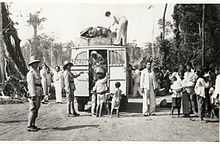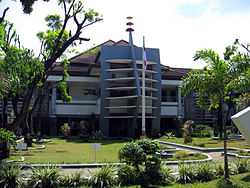Metro, Lampung
| Metro City | ||
|---|---|---|
| City | ||
|
Metro's mayor's office | ||
| ||
 Metro City | ||
| Coordinates: 5°7′S 105°18′E / 5.117°S 105.300°ECoordinates: 5°7′S 105°18′E / 5.117°S 105.300°E | ||
| Country | Indonesia | |
| Province | Lampung | |
| Settlement commenced | 1939 | |
| Administrative city | 14 August 1986 | |
| Autonomous city | 27 April 1999 | |
| Government | ||
| • Mayor | Lukman Hakim | |
| Area | ||
| • Total | 68.74 km2 (26.54 sq mi) | |
| Elevation | 30–60 m (98–197 ft) | |
| Population (2014) | ||
| • Total | 152,428 | |
| • Density | 2,200/km2 (5,700/sq mi) | |
| Time zone | WIB (UTC+7) | |
| Area code(s) | 0275 | |
| Vehicle registration | BE | |
| Website | www.metrokota.go.id | |
Metro ([ˈmetro]; historically known as Trimurjo) is an Indonesian city (kota) located in Lampung. Founded in 1936, it covers an area of 68.74 square kilometres (26.54 sq mi) and had a population of 145,346 at the 2010 Census; the latest official estimate (for January 2014) is 152,428.
Etymology
Metro comes from the Javanese word mitro, meaning friend.[1][2] The name was chosen to remind the migrants to work together.
History

Prior to 1936, Trimurjo was part of Gunungsugih onder distric;[3] it was isolated, without much influence from the indigenous Lampungese people.[4] However, beginning in 1936 the Dutch colonial government sent Javanese migrants to colonise the area, which served to relieve overpopulation on Java, and mitigate the influence of Indonesian independence activists.[5] The first group arrived on 4 April 1936.[6]
On 9 June 1937, the name of the area was changed from Trimurjo to Metro[1] and that same year it was established as a separate onder distric, with Raden Mas Sudarto as the first assistant district chief. During this same period the Dutch colonial government built more roads, as well as a clinic, police office, and administrative offices.[7] By 1941 a mosque, post office, large market, and inn had been built, and electricity and telephone lines had been installed.[8]
Development soon outpaced the natural irrigation capabilities of the area. To ensure proper healthy crops, the Dutch hired Ir. Swam to design an irrigation system. His design called for a levee as well as a 30 metres (98 ft) wide and 10 metres (33 ft) deep irrigation canal from Way Sekampung River to Metro. Labour was provided by the migrants, who were conscripted and worked in shifts. Construction began in 1937 and was finished in 1941.[9]
After the Japanese invasion of Indonesia in 1942, all Dutch personnel were evacuated or captured.[10] The migration program was continued under the name imin kakari,[11] and seventy Javanese migrants were used as forced labour in the construction of the nearby Natar and Astra Ksetra airstrips as well as numerous bunkers and other strategic assets; those who resisted were shot.[10]
The remaining citizens were malnourished, with their harvests being taken by the Japanese occupying forces. Diseases spread rampantly throughout the populace, carried by ticks. Deaths were common, as were women, including wives of the forced labourers, being taken as comfort women.[11]
During the Indonesian war of independence, the Dutch attempted to retake Metro. When they first arrived, they were unable to enter as the bridge to the city in Tempuran had been destroyed by a 26-man troop of the Indonesian army, under the command of Second Lieutenant Bursyah; the Dutch convoy was forced to retreat. However, the following day the Dutch returned in greater numbers and attacked from Tegineneng, eventually entering the city and killing three Indonesian soldiers.[12]
Upon entering the city, the Dutch forces were besieged by sabotage by 41 soldiers under the command of Second Lieutenant Raden Sudarto. After chasing Sudarto’s forces throughout the area, the Dutch continued to Palembang. Despite an extended guerrilla campaign by the Indonesian military, the Dutch eventually retook Metro in 1949, surrendering it that same year.[13]
After the war, Metro continued to develop. In 1956, its government was stylized as a negeri based on Governor’s Decree Number 153/D/1956. This led to adat lands being owned by the local government.[14]
In 1976 Metro became the capital of the newly formed Central Lampung Regency, which at the time included parts of present-day East Lampung Regency.[15]

Beginning in 1985, the local government began working to stimulate the economy. Retail chains began entering the city, a movie theatre and stadium was built, the town square was redesigned as a park, and Cendrawasih market was renovated.[16]
On 14 August 1986, Metro was designated an administrative city, in accordance with Government Decree Number 34 of 1986, with the formal ceremony taking place on 6 September 1987.[17]
Metro was established as an autonomous city (kota) with the passing of Law Number 12 of 1999 on 27 April 1999,[18] with Gunungsugih becoming the capital of Central Lampung.[19] The first mayor after Metro’s establishment as an autonomous city was Mozes Herman, with Lukman Hakim as vice-mayor.[20] Lukman Hakim is currently the mayor of Metro.[21]
Geography and climate
Metro is spread over an area of 68.74 square kilometres (26.54 sq mi),[22] with the built up area consisting of 24.57% of the city, or 16.88 square kilometres (6.52 sq mi).[23] As of 2010, it has a population of 145,346, with a density of 2,116.2 people per km2 (5,480.9/sq mi);[24] the latest estimate is 152,428.
The city is built around the Dutch land use planning system. Its economic and political hub is in the center, in the area around the city park. All five provincial and national roads that transect Metro meet in this area.[25] Northern Metro is a residential area, while western Metro is used for commercial space, southern Metro for agriculture, and parts of southern and eastern Metro for educational and other public facilities.[26]
The land in Metro is relatively flat, with an elevation between 30 to 60 metres (98–197 ft).[27] When it was first settled, the area was heavily forested; there are still pockets of forest within the city limits.[6]
When Metro was originally made an autonomous city, it had two kecamatan, or subdistricts, Metro Raya and Metro Bantul.[18] However, it now has five.[27]
The climate in Metro is humid and tropical. The average air temperature is between 26 and 28 °C (79 and 82 °F), with an average humidity of 80 to 88% and an average yearly precipitation of 2,264 to 2,868 millimetres (89.1 to 112.9 in). The dry season usually lasts from September until May.[27]
Economy
In 2002, Metro had a budget of Rp 336 billion (USD 37.3 million).[28] The largest contributor to Metro’s economy is the service sector, contributing 22.94% of the city’s income in 2002.[29]
The second largest contributor to Metro’s economy is retail, contributing 19.77% of the city’s 2002 income.[29] In 2004, there were 13 markets, 1,881 stores, and 682 food kiosks, as well as numerous street vendors.[30]
The third largest economic sector is agriculture, contributing 17.31% of the 2002 income.[29] Within the city boundaries there are 3,342 hectares of rice fields, capable of producing up to 16,598 tons of rice per growing season.[31]
Numerous banks have branches in Metro, including Bank Mandiri, Bank Lampung, Bank Danamon, Bank Eka, Bank Central Asia, Bank Rakyat Indonesia, Bank Internasional Indonesia, and as well as Bank Negara Indonesia.[30]
HIM Damsyik International Airports
In Metro there is an international airport built August 2014, this airport has the IATA code: MTO and ICAO: WASS. Airport which is 13/31 size 2,950 by 45 metres (9,678 ft × 148 ft). The airport is the second largest airport in Indonesia after the Gunung Batin Airport made Astraksetra market & Radin Inten II Airport, above sea level is located on a State Printing, Metro City.
This airport is a managed by PT. Angkasa Pura I (Persero) & Government Metro City since its renovation.
Healthcare
Metro is served by three hospitals: Ahmad Yani General Hospital, Mardi Waluyo Hospital, and Metro Islamic Hospital. As of 2003, the total number of health care practitioners in Metro is 382, including 13 specialists, 30 general practitioners, 36 midwives, 121 nurses, and 8 dentists. There are also 19 pharmacies and 8 drug stores.[32]
Education
Metro is served by numerous public and private schools. There are 63 elementary schools, 25 junior high schools (eight public and seventeen private), two junior high schools for special-needs children, 16 senior high schools, and 15 vocational schools.[33]
There are ten tertiary education facilities located in Metro, namely:[29]
- Muhammadiyah University of Metro
- Agus Salim Tarbiyah School of Higher Learning
- Ma’arif Islamic School of Higher Learning
- Metro State Islamic School of Higher Learning
- Dharma Wacana School of Athletic Education
- Dharma Wacana School of Management, IT and Computers
- Dharma Wacana School of Agriculture
- Dharma Wacana Nursing Academy
- Dharma Wacana School of Politics
- Metro Academy of Midwifery.
References
- ↑ 1.0 1.1 Sudarmono & Edi Ribut Harwanto 2004, p. 28
- ↑ Prahana 1997, p. 20
- ↑ Sudarmono & Edi Ribut Harwanto 2004, p. 18
- ↑ Sudarmono & Edi Ribut Harwanto 2004, p. 2
- ↑ Sudarmono & Edi Ribut Harwanto 2004, p. 25
- ↑ 6.0 6.1 Sudarmono & Edi Ribut Harwanto 2004, p. 20
- ↑ Sudarmono & Edi Ribut Harwanto 2004, pp. 29–30
- ↑ Sudarmono & Edi Ribut Harwanto 2004, p. 30
- ↑ Sudarmono & Edi Ribut Harwanto 2004, pp. 31–39
- ↑ 10.0 10.1 Sudarmono & Edi Ribut Harwanto 2004, pp. 48–50
- ↑ 11.0 11.1 Sudarmono & Edi Ribut Harwanto 2004, p. 54
- ↑ Sudarmono & Edi Ribut Harwanto 2004, pp. 58–59
- ↑ Sudarmono & Edi Ribut Harwanto 2004, pp. 62–67
- ↑ Sudarmono & Edi Ribut Harwanto 2004, p. 71
- ↑ Sudarmono & Edi Ribut Harwanto 2004, p. 72
- ↑ Sudarmono & Edi Ribut Harwanto 2004, pp. 76–79
- ↑ Sudarmono & Edi Ribut Harwanto 2004, p. 82
- ↑ 18.0 18.1 Sudarmono & Edi Ribut Harwanto 2004, p. 93
- ↑ Sudarmono & Edi Ribut Harwanto 2004, p. 4
- ↑ Sudarmono & Edi Ribut Harwanto 2004, p. 84
- ↑ "Pemerintah dan Muspida Kota Beserta Jajarannya" (in Indonesian). Metro City Government. 2010. Retrieved 6 July 2011.
- ↑ Sudarmono & Edi Ribut Harwanto 2004, p. 137
- ↑ Sudarmono & Edi Ribut Harwanto 2004, p. 120
- ↑ "Jumlah Penduduk, Rumah Tangga dan Rata2 Jiwa/Rumah Tangga, 2010" (in Indonesian). Badan Pusat Statistik Lampung. 2010. Retrieved 6 July 2011.
- ↑ Sudarmono & Edi Ribut Harwanto 2004, p. 142
- ↑ Sudarmono & Edi Ribut Harwanto 2004, pp. 144–145
- ↑ 27.0 27.1 27.2 "Metro selayang pandang". Metro City Government. 2010. Retrieved 6 July 2011.
- ↑ Sudarmono & Edi Ribut Harwanto 2004, p. 149
- ↑ 29.0 29.1 29.2 29.3 Sudarmono & Edi Ribut Harwanto 2004, p. 134
- ↑ 30.0 30.1 Sudarmono & Edi Ribut Harwanto 2004, p. 153
- ↑ Sudarmono & Edi Ribut Harwanto 2004, p. 124
- ↑ Sudarmono & Edi Ribut Harwanto 2004, pp. 137–139
- ↑ Sudarmono & Edi Ribut Harwanto 2004, pp. 129–130
Bibliography
- Prahana, Naim Empel (1997). Cerita rakyat dari Lampung [Folklore from Lampung] (in Indonesian) 2. Jakarta: Gramedia Widiasarana Indonesia. ISBN 979-669-015-2.
- Sudarmono; Edi Ribut Harwanto, eds. (2004). Metro: Desa Kolonis Menuju Metropolis [Metro: A Colonial Village Becoming Metropolitan] (in Indonesian). Metro, Indonesia: Bagian Humas dan Protokol Setda Kota Metro.
External links
| |||||||||||||||||

